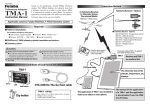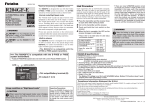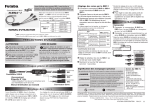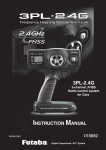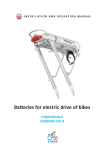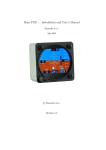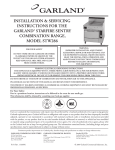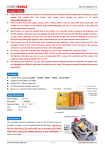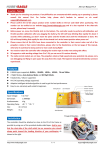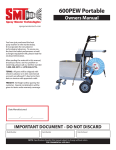Download SBS-01V
Transcript
1M23N26714 Voltage sensor SBS-01V Instruction Manual Thank you for purchasing Futaba's SBS-01V Voltage Sensor. This sensor, used in conjunction with a telemetry enabled transmitter/receiver, is used to indicate the voltage of the item to which it is attached. Although the telemetry receiver of Futaba's has a function which measures voltage, if SBS-01V is used, it can measure more battery voltage. To maximize your enjoyment, and to ensure proper sensing, please read through this manual thoroughly. We also encourage you to retain the manual for future reference should the need arise. to EXT Battery EXT Line ● The SBS-01V is designed for use with Futaba telemetry systems. Features ■ The SBS-01V will not function properly if connected to an S.BUS port or other channel ports. Measures receiver battery voltage and the voltage of a second battery or power supply. External Line Range : 0-100V's To ensure that the SBS-01V is functioning as desired, please test accordingly. Weight : 0.2oz (6.0g) ■ Do not fly until inspection is complete. Length : 34.25in (870mm) Do not use the SBS-01V with anything other than an R/C model. In order to prevent any short circuits, please observe the polarity of all connections. ■ Ensure that the unit is connected properly; failure to do so could result in damage to the cable, receiver, etc. Always mount the cable in accordance with the instructions included in this manual. Allow a slight amount of slack in the cable. Normal Line SBS-01V 3P Connector Green/Red Unrecoverable error Alternate blink Slot Number Setup SBS-01V uses two continuous slots. Please note that the proper default start slot for this accessory is number 6. When setup-changing or adding, it is the following numbers that are made to a start slot. 1,2,3,4,5,6,8,9,10,11,12,13,14,16,17, 18,19,20,21,22,24,25,26,27,28,29,30 Information on how to change the slot assignment is included in the transmitter's manual. Battery connection What is measured is total voltage when the battery which you want to measure has two or more cells. One cell of a battery with many cells cannot be measured. Don't carry out connection wiring at one cell. If it connects with one cell, there is fear of ignition. Turn on the receiver prior to connecting the Extra Voltage Input. To prevent any short circuits, please ensure that the cable is routed away from any conducive materials. Don't apply voltage higher than 100V to Extra voltage line. ■ There is fear of explosion, ignition, and breakage. S.BUS2 port The example of wiring LED Indication Green/Red ■ If necessary, fasten this cable at a suitable location to prevent any damage from vibration during flight. It is cautious of the burn and fire in wiring work enough. The work of wiring must not connect a battery. Heat Shrink Tube Normal operation No signal reception When setting up the slot Ensure that the unit is connected properly to the receiver. Failure to do so could result in damage to the sensor. Ensure that the unit is mounted in an area that will eliminate exposure to fuel, water and vibration. ■ As with any electronic components, proper precautions are urged to prolong the life and increase the performance of the SBS-01V. Normal Line Range : 3.5-8.4V's to Green Red Failure to follow these safety precautions may result in severe injury to yourself and others. To utilize the SBS-01V altitude sensor, connect it to the S.BUS2 port of the Futaba telemetry enabled receivers. LED Fuse(mount in either direction) WARNING Two drive batteries are measured (R7008SB use) Drive battery 1 (EXT Battery) to S.BUS2 port Drive battery 2 (EXT Battery) EXT Line Normal Line R7008SB Receiver battery ●Battery voltage measurement for receivers [R7008SB use] ●The drive battery 1 is measured in an EXT port [R7008SB use] ●The drive battery 2 is measured in an EXT line [SBS-01V use] Two drive batteries and power supplies for servos are measured (R7008SB use) Drive battery 1 (EXT Battery) Drive battery 2 (EXT Battery) Power supplies for servos *SBS-01V measures two voltage. One corresponds to high voltages, such as a drive battery, with an EXT line. Another is a normal line and is measurement of the battery for receivers of a line connected to 3P connector, or the battery for servos. EXT Line Switch Normal Line to S.BUS2 port Another power supply Hub R7008SB Receiver battery S.BUS2 servos ●Battery voltage measurement for receivers [R7008SB use] ●The drive battery 1 is measured in an EXT port [R7008SB use] ●The drive battery 2 is measured in an EXT line [SBS-01V use] ●The voltage for servos is measured in a power supply line [SBS-01V use] The wiring processing method of an EXT Line ① Measure the cable and then cut it to the desired length. cable SBS-01V ② Cut approximately 30mm of the negative (-, black) line from the cable. Solder the fuse inline on the negative wire and then reattach the section of wire that was previously removed. The fuse should be attached as close to the external power supply as possible. Solder welding The fuse should be attached as close to the external power supply as possible. Fuse to Black line (-) Fuse(mount in either direction) ③ Place a piece of heat shrink tubing over the fuse, ensuring that it covers the soldered areas. Shrink the tubing snug to the fuse and the wire using a heat gun. Heat shrink tube Heat shrink Heat shrink tube ④ The cable should be connected as shown in the diagram below. The cable gets connected to the wires that come off the ESC and connect to the battery. To Receiver S.BUS2 port Fuse To Power Battery motor controller To Motor The connection is affixed to the ESC on the wires that are connected to the battery by soldering them and then protecting them with heat shrink. ⑤ The manual for the Telemetry system should be referred to after the setup is complete; checking to make sure it functions as desired and that it provides the correct voltage on the display. FUTABA CORPORATION 1080 Yabutsuka, Chosei-mura, Chosei-gun, Chiba-ken, 299-4395, Japan Phone: +81 475 32 6982, Facsimile: +81 475 32 6983 ©FUTABA CORPORATION 2012, 10 (1)


